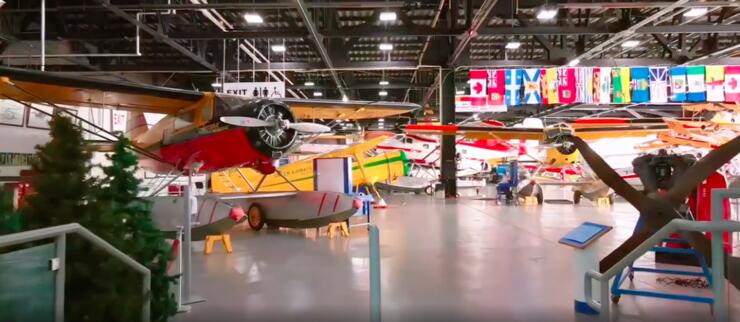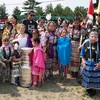

A Guide to Canada's Bushplane Heritage Centre
Located on the shores of Sault Ste. Marie in Algoma Country is the Canadian Bushplane Heritage Centre—a museum like no other. The planes on display here document a distinctive chapter in Canada’s aviation history. Before passenger and commercial flights existed, bush planes—and their highly skilled, daredevil pilots—kept remote communities connected to the rest of Canada. The hub of this industry was in Northern Ontario, a place that’s forever on the international map due to these early flying machines.

Here we dive into the history of the planes and how to visit the Bushplane Heritage Centre in Sault Ste. Marie on your next trip to Northern Ontario!
What's the History of the Bushplane? Learn About The Dawn of Bush Flying


At the end of World War 1, hundreds of pilots returned to Canada with a skill that few people in the country had. Even though flight was experimental at that time, four years of military service overseas had produced expert pilots who were now unemployed. Among them was Royal Navy pilot Stuart Graham. He was hired by a group of pulp and paper companies in Quebec to perform air patrols for fire protection and conduct aerial surveying of timber limits. On June 8, 1919, Graham flew a wartime biplane (Curtiss HS-2L) from Halifax, Nova Scotia, to Lac a la Tortue, Quebec. Not only was this trip the first forest fire reconnaissance flight in Canada, but it also marked the dawn of bush flying (named for the forest lands that pilots flew over) in the world. It’s widely believed that the words "bush plane" and "bush pilot" originated in Canada.
How the Bushplane Was Instrumental in the Development of Ontario. Yours to Discover!
Shortly after Stuart’s flight in 1919, another first was achieved. According to the CBHC’s founding president, Bob Thomas, “Using these same type of aircraft, the first commercial flying operation was started by Laurentide Air Services in Ontario in 1920. Over the next two years Laurentide would map more than 20,000 square miles of northern bush west to Manitoba and north to James Bay.”
In 1924, the Ontario Provincial Air Service was established, operated by the Ontario Ministry of Forests. The CBHC’s Executive Director, Jamie Hilsinger says, “The Ontario Provincial Air Service selected Sault Ste. Marie as its home base because of its northern location and on the fast-flowing St. Mary's River, which never froze over. The original hangar was the largest in Canada when it was first built, and was constructed of steel and brick as opposed to wooden structures which were the norm.”
The decision on where to establish the Air Service was made by James Lyons, Minister of Forests, who was the member of provincial parliament for Sault Ste. Marie.

The Ontario Provincial Air Service became the leading bush plane agency in Canada. Bush planes (and their pilots, sometimes known as Arctic Aviators) from Ontario were known around the world. Due to its historical and architectural importance, the hangar was designated a heritage site for Sault Ste. Marie.
Documenting Canada's North
While aerial mapping and documenting forest inventories was the original purpose, bush planes were utilized to achieve a number of other purposes, including spotting remote forest fires. “Natural resources, particularly timber and minerals, were valuable but relatively unknown commodities. The challenge was to conduct aerial surveys to map vast wilderness areas that had never been seen by European eyes. Before the advent of aerial photography, surveys and mapping was done by a sketcher making hand drawn maps and identifying forest types, from the open cockpit at the front of the plane,” says Thomas.
A variety of aircraft, none designed explicitly for or suited to the demands of bush flying operations, were employed initially and into the 1930s. The first planes operated on water landing on their boat-like hulls. Later machines were flown on floats in the summer and skis in winter operations.

Connecting Canada's North
Bush planes also provided essential services to remote communities—everything from food to medicines to building materials. They were often used to fly people out to hospitals in medical emergencies. “To the small, remote northern communities the aircraft meant an end to isolation, particularly during the long, harsh northern winters. Besides being a ship of discovery, the diminutive aircraft became a supply line and a lifeline to the outside world. Often flying on instinct over the uncharted wilderness, and in all kinds of weather, these pioneering aviators linked remote settlements. They opened the way to development and commerce,” says Thomas.
Aviators (and Historians) Rejoice: The Bushplane Museum Is Born

In the 1980s, there was interest in preserving bush plane history. According to Thomas, “Although a variety of books had been published about aviation operations in Canada's north, much of the hands-on materials and artefacts were being neglected and lost. There was no focal point to collect, document, and preserve written or oral histories. There was no repository for aviation-related artefacts, photographs, aircraft parts, and even whole aircraft.”
In 1989, the Canadian Bushplane Heritage Centre was established in what would become the former Ontario Provincial Air Service hangar.
What Is There To See At the Canadian Bushplane Heritage Centre? How About 24 Bush Planes!
For bush plane enthusiasts (and even those who are just discovering them), the museum is a fascinating journey into Canada’s earliest aviation. Walking in the front doors, you are greeted by a full-size replica of Canada’s Silver Dart, suspended from the lobby ceiling. It was the aircraft which performed the first heavier-than-air, powered flight in the British Empire. On entering the hangar, you’ll see 24 aircraft. The diversity of these flying machines (in shape, size, and technical prowess) is remarkable. One can only wonder how exciting (albeit dangerous) it must have been to fly one of these planes and see the vast scope of Canada’s wilderness for the first time!

Probably the most noteworthy aircraft on display is the Beaver. According to Thomas, “The museum's Beaver, CF-OBS, is the first Beaver off the production line in 1948. De Havilland would go on to produce more than 1,600 Beavers, and it's estimated that more than half are still flying all over the world. Lauded as one of the most reliable and safest aircraft built, the Beaver was the lead aircraft utilized in the initial development of aerial waterbombing of forest fires.”

Another plane with great significance is the CL-215. “The CL-215 wasn’t so much a development in bushplane flying but more so in forest fire control. The hull-like design of the aircraft allows it to skim large quantities of water from small lakes and rivers – it’s a surprisingly stable and agile plane. The CL-215 is called a “waterbomber” because it can scoop up over 6,000 litres of water in 12 seconds and accurately “bomb” a forest fire from low altitudes. This process was a huge improvement in aerial forest fire management technology and replaced roll tanks on smaller aircraft such as the Beaver.” says Hilsinger.
Top 5 Things to See at the Sault Ste. Marie Bushplane Museum

- Get in the cockpit! Many of the planes are open for you to explore—so climb on up and experience a bush plane IRL.
- Step into the Flight Adventure Simulator and experience what it’s like to take off from the water on a float plane, see views of Sault Ste. Marie, and experience a tense landing.
- Watch a 3D film with forest fire fighting special effects all around you. The film shows how the Ministry of Natural Resources and Forestry’s Aviation, Forest Fire and Emergency Services tackles forest fires in Ontario, from the air, and on the ground.
- Enjoy the Women in Aviation Exhibit, which explores the incredible history of women and flight, from the earliest years of aviation to space missions. You’ll learn about Eileen Vollick, Canada’s first woman pilot.
- See the featured exhibit: Joe Murray’s Canadian Heritage RC Aircraft Series. It honours a prolific Canadian modeller and features the original prototypes for radio-controlled model plane kits from 30 to 35 years ago.
Neat Things You May Not Expect
There is a super cool Northern Nature Trade at the museum. No, it’s not for clothes, but rather for things you find outdoors (as long as they are not alive). Anyone can bring in a rock and trade it, let’s say, for a seashell or a pine cone.
Also located at the CBHC is Entomica, an insectarium that’s home to live exotic insects from around the world that you can see up close and touch!
Frequently Asked Questions about the Bushplane Heritage Center
Where is Canada's Bushplane Heritage Centre?
The Bushplane Heritage Centre is located in the waterfront city of Sault Ste. Marie, Ontario, Canada. It's just across the border from Northern Michigan, and close to three of the Great Lakes. The address is 50 Pim St, Sault Ste. Marie, ON P6A 3G4, Canada.
When is the Bushplane Heritage Centre Open?
The Bushplane Heritage Centre is open 7 days a week from 9 am to 5 pm.
Can I Go Inside the Planes at the Bushplane Heritage Centre?
Yes! There are numerous planes where visitors can get up close and personal. Just climb the stairs and head on in to check out the cockpits and seating arrangements of these historic craft.
Plan Your Trip to the Canadian Bushplane Heritage Centre in Sault Ste. Marie, Algoma Country Today!

Admire classic bushplane up close on your next visit to Sault Ste. Marie, Credit: Canadian Bushplane Heritage Centre
On your next trip to Sault Ste. Marie, stop in at this Canadian treasure. And if you live in town, consider volunteering or hosting a special event, such as a wedding (yes, nuptials have been held here with bush planes as the backdrop!)
Recommended Articles

9 Facts to Know about the Agawa Canyon Tour Train

A Guide to the Best Urban Fishing in Sault Ste. Marie, Ontario

Where to Eat, Dine, and Play on the Sault Ste. Marie Waterfront

Cruising to the Next Level

Why the Fall Is a Great Time to Visit Sault Ste. Marie
Canoe & Kayak Sault Ste. Marie

Peace Restaurant































